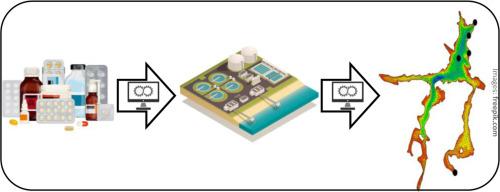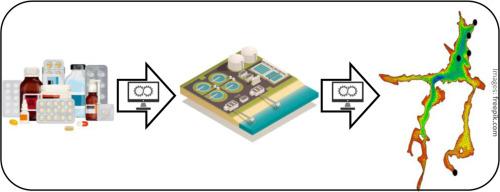开发和验证一种新的方法来预测在一个湖泊接收废水的有效药物成分的时空浓度动态
IF 12.4
1区 环境科学与生态学
Q1 ENGINEERING, ENVIRONMENTAL
引用次数: 0
摘要
人类对药物的消费导致活性药物成分(api)持续排放到水生环境中,主要是通过废水处理厂(WWTPs)。然而,环境API浓度的时空格局很难用传统的化学测量方法来评估。因此,化学品风险评估通常基于低分辨率数据,并且经常忽略API浓度对环境的影响。因此,我们开发了一种新的方法,结合发射和水动力模型来估计时空变化。该方法应用于瑞典一个湖泊的案例研究中,该湖泊接收来自污水处理厂的水(容量为20万人当量),其中包括500多种处方原料药。使用每月在污水处理厂流出物中测量的10种不同的API对排放模型进行了验证,在103种测量的API浓度中,102种的预测值在10的因子范围内。通过对该湖的321次历史测量验证了完整的方法,涵盖了20种不同的api,其中233次(73%)和319次(99%)的测量值分别在10和100的倍数内。因此,我们的方法能够预测api的环境浓度,足够准确,可以直接从人类处方数据中补充和指导环境监测。此外,我们证明API浓度随时间和空间的变化而变化,直接影响风险管理和监测。本文章由计算机程序翻译,如有差异,请以英文原文为准。


Development and validation of a new method for predicting spatial and temporal concentration dynamics of active pharmaceutical ingredients in a lake receiving wastewater effluents
Human consumption of pharmaceuticals leads to continuous emissions of active pharmaceutical ingredients (APIs) to the aquatic environment, primarily via wastewater treatment plants (WWTPs). However, temporal and spatial patterns of environmental API concentrations are challenging to assess using conventional chemical measurements. Chemical risk assessments are, consequently, typically based on low-resolution data and often overlook API concentrations of environmental concern. We, therefore, developed a new method, combining emission and hydrodynamic modeling to estimate spatiotemporal variations. The method was applied in a case study in a Swedish lake receiving water from a WWTP (capacity 200,000 person equivalents), including >500 prescription APIs. The emission model was validated using ten different APIs measured monthly in the WWTP effluent, and of 103 measured API concentrations 102 were predicted within a factor of 10. The full method was validated against 321 historical measurements from the lake, covering 20 different APIs where 233 (73%) and 319 (99%) of the predicted concentrations were within a factor of 10 and 100 of the measurements. Thus, our method enables predictions of environmental concentrations of APIs, accurate enough to supplement and guide environmental monitoring, directly from human prescription data. Furthermore, we demonstrate that API concentrations vary by orders of magnitude over time and space, directly impacting risk management and monitoring.
求助全文
通过发布文献求助,成功后即可免费获取论文全文。
去求助
来源期刊

Water Research
环境科学-工程:环境
CiteScore
20.80
自引率
9.40%
发文量
1307
审稿时长
38 days
期刊介绍:
Water Research, along with its open access companion journal Water Research X, serves as a platform for publishing original research papers covering various aspects of the science and technology related to the anthropogenic water cycle, water quality, and its management worldwide. The audience targeted by the journal comprises biologists, chemical engineers, chemists, civil engineers, environmental engineers, limnologists, and microbiologists. The scope of the journal include:
•Treatment processes for water and wastewaters (municipal, agricultural, industrial, and on-site treatment), including resource recovery and residuals management;
•Urban hydrology including sewer systems, stormwater management, and green infrastructure;
•Drinking water treatment and distribution;
•Potable and non-potable water reuse;
•Sanitation, public health, and risk assessment;
•Anaerobic digestion, solid and hazardous waste management, including source characterization and the effects and control of leachates and gaseous emissions;
•Contaminants (chemical, microbial, anthropogenic particles such as nanoparticles or microplastics) and related water quality sensing, monitoring, fate, and assessment;
•Anthropogenic impacts on inland, tidal, coastal and urban waters, focusing on surface and ground waters, and point and non-point sources of pollution;
•Environmental restoration, linked to surface water, groundwater and groundwater remediation;
•Analysis of the interfaces between sediments and water, and between water and atmosphere, focusing specifically on anthropogenic impacts;
•Mathematical modelling, systems analysis, machine learning, and beneficial use of big data related to the anthropogenic water cycle;
•Socio-economic, policy, and regulations studies.
 求助内容:
求助内容: 应助结果提醒方式:
应助结果提醒方式:


